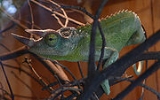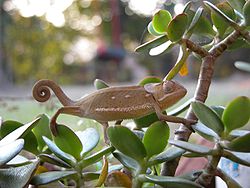
Chamaeleo
Encyclopedia

Genus
In biology, a genus is a low-level taxonomic rank used in the biological classification of living and fossil organisms, which is an example of definition by genus and differentia...
of chameleon
Chameleon
Chameleons are a distinctive and highly specialized clade of lizards. They are distinguished by their parrot-like zygodactylous feet, their separately mobile and stereoscopic eyes, their very long, highly modified, and rapidly extrudable tongues, their swaying gait, the possession by many of a...
s found primarily in the mainland of sub-saharan Africa
Sub-Saharan Africa
Sub-Saharan Africa as a geographical term refers to the area of the African continent which lies south of the Sahara. A political definition of Sub-Saharan Africa, instead, covers all African countries which are fully or partially located south of the Sahara...
, but a few species are also present in northern Africa, southern Europe
Southern Europe
The term Southern Europe, at its most general definition, is used to mean "all countries in the south of Europe". However, the concept, at different times, has had different meanings, providing additional political, linguistic and cultural context to the definition in addition to the typical...
and southern Asia
Asia
Asia is the world's largest and most populous continent, located primarily in the eastern and northern hemispheres. It covers 8.7% of the Earth's total surface area and with approximately 3.879 billion people, it hosts 60% of the world's current human population...
east to India
India
India , officially the Republic of India , is a country in South Asia. It is the seventh-largest country by geographical area, the second-most populous country with over 1.2 billion people, and the most populous democracy in the world...
and Sri Lanka
Sri Lanka
Sri Lanka, officially the Democratic Socialist Republic of Sri Lanka is a country off the southern coast of the Indian subcontinent. Known until 1972 as Ceylon , Sri Lanka is an island surrounded by the Indian Ocean, the Gulf of Mannar and the Palk Strait, and lies in the vicinity of India and the...
. They are slow moving with independently movable eyes, the ability to change skin colouration, long tongue, prehensile tail
Prehensile tail
A prehensile tail is the tail of an animal that has adapted to be able to grasp and/or hold objects. Fully prehensile tails can be used to hold and manipulate objects, and in particular to aid arboreal creatures in finding and eating food in the trees...
and special leg adaptations for grasping vegetation
Vegetation
Vegetation is a general term for the plant life of a region; it refers to the ground cover provided by plants. It is a general term, without specific reference to particular taxa, life forms, structure, spatial extent, or any other specific botanical or geographic characteristics. It is broader...
. Males are generally larger and more colorful than females. Almost all species have a maximum length between 15 and 40 cm (5.9 and 15.7 in).
The vast majority are arboreal and typically found in trees or bushes, but a few species (notably the Namaqua Chameleon
Namaqua Chameleon
The Namaqua Chameleon is a ground living lizard found in the Namib Desert of Namibia and southern Angola.-Survival Techniques:...
) are partially or largely terrestrial
Terrestrial animal
Terrestrial animals are animals that live predominantly or entirely on land , as compared with aquatic animals, which live predominantly or entirely in the water , or amphibians, which rely on a combination of aquatic and terrestrial habitats...
. The genus includes only oviparous species. With few exceptions, the chameleons most commonly seen in captivity
Captivity (animal)
Animals that live under human care are in captivity. Captivity can be used as a generalizing term to describe the keeping of either domesticated animals or wild animals. This may include for example farms, private homes and zoos...
are all members of Chamaeleo, notably the Common, Senegal and Veiled
Veiled Chameleon
The veiled chameleon, Chamaeleo calyptratus, is a large species of chameleon found in the mountain regions of Yemen, United Arab Emirates and Saudi Arabia. It is also sometimes referred to as the Yemen Chameleon....
chameleons, but even they require special care.
Taxonomy
Chamaeleo is the type genusType genus
In biological classification, a type genus is a representative genus, as with regard to a biological family. The term and concept is used much more often and much more formally in zoology than it is in botany, and the definition is dependent on the nomenclatural Code that applies:* In zoological...
of the family Chamaeleonidae.
All other genera of the subfamily Chamaeleoninae (Bradypodion
Bradypodion
Bradypodion is one of six genera of chameleons within the "true" or "typical" chameleons . They are native to southern Africa, and are sometimes collectively called South African dwarf chameleons...
, Calumma
Calumma
Calumma is a genus of chameleons where all species are endemic to Madagascar. Following CITES, it is now illegal to import any of the species from their native countries.-Classification of genus Calumma:* Calumma amber...
, Furcifer
Furcifer
Furcifer is a genus of chameleons whose members are mostly endemic to Madagascar, but F. cephalolepis and F. polleni are endemic to the Comoros. Additionally, F. pardalis has been introduced to Réunion and Mauritius, while F. oustaleti has been introduced to near Nairobi in Kenya...
, Kinyongia
Kinyongia
Kinyongia is a chameleon genus that recently was established for several plesiomorphic species found in forest and woodland in Kenya, Tanzania, Uganda, Rwanda and far eastern DR Congo. All except K. adolfifriderici and K. tavetana are restricted to highlands and many have very small distributions....
, Nadzikambia
Nadzikambia
There are currently two species in the recently established genus Nadzikambia . They are plesiomorphic, small chameleons from the Ruo Gorge forest on Mount Mulanje in Malawi and Mount Mabu in Mozambique....
and Trioceros
Trioceros
Trioceros is a genus in the family Chamaeleonidae. It was previously considered a subgenus of the genus Chamaeleo until 2009 when it was elevated to full genus level.-Species:...
) have at some point been included in the genus Chamaeleo, but are now regarded as separate by virtually all authorities.
- African Chameleon, Chamaeleo africanus
- Angola Double-scaled Chameleon, Chamaeleo anchietae
- Arabian Chameleon, Chamaeleo arabicus
- Awash Spurless Chameleon, Chamaeleo calcaricarens
- Veiled Chameleon, Chamaeleo calyptratus
- Veiled Chameleon, Chamaeleo calyptratus calyptratus
- Short-casqued Veiled Chameleon, Chamaeleo calyptratus calcarifer
- Common Chameleon, Chamaeleo chamaeleonChamaeleo chamaeleonThe Common Chameleon is the only species of Chamaleonidae of Europe.-Subspecies:Four sub-species are identified:*Chamaeleo chamaeleon chamaeleon*Chamaeleo chamaeleon musae*Chamaeleo chamaeleon orientalis*Chamaeleo chamaeleon rectricrista...
- European Common Chameleon, Chamaeleo chamaeleon chamaeleon
- Sinai Peninsula Common Chameleon, Chamaeleo chamaeleon musae
- Arabian Common Chameleon, Chamaeleo chamaeleon orientalis
- Middle East Common Chameleon, Chamaeleo chamaeleon rectricrista
- Flap-necked Chameleon, Chamaeleo dilepisChamaeleo dilepisThe Flap-necked Chameleon, Chamaeleo dilepis, is native to Sub-Saharan Africa. It is a large chameleon, reaching . Like other chameleons, this species can change colour and pattern to suit the surroundings. Colouring ranges through various shades of green, yellow and brown. There is usually a pale...
- Flap-necked Chameleon, Chamaeleo dilepis dilepis
- Idjwi Island Flap-necked Chameleon, Chamaeleo dilepis idjwiensis
- Isabelline Flap-necked Chameleon, Chamaeleo dilepis isabellinus
- Pemba Island Flap-necked Chameleon, Chamaeleo dilepis martensi
- Peters' Flap-necked Chameleon, Chamaeleo dilepis petersii
- Etienne's Slender Chameleon, Chamaeleo etiennei
- Graceful Chameleon, Chamaeleo gracilis
- Smooth Chameleon, Chamaeleo laevigatus
- Socotran Chameleon, Chamaeleo monachus
- Namaqua Chameleon Chamaeleo namaquensis
- Necas' Flap-necked Chameleon, Chamaeleo necasi
- Quilo River Flap-necked (or Bocage's) Chameleon, Chamaeleo quilensis
- Roper's Flap-necked Chameleon, Chamaeleo roperi
- Ruspoli's Ogaden Flap-necked Chameleon, Chamaeleo ruspolii
- Senegal Chameleon, Chamaeleo senegalensis
- Indian Chameleon, Chamaeleo zeylanicusChamaeleo zeylanicusThe Indian Chameleon, Chamaeleo zeylanicus is a species of chameleon found in Sri Lanka, India and other parts of South Asia. Like other chameleons, this species has a long tongue, feet that are shaped into bifid claspers, a prehensile tail, independent eye movement and the ability to change skin...

